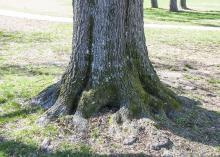Information Possibly Outdated
The information presented on this page was originally released on February 7, 2013. It may not be outdated, but please search our site for more current information. If you plan to quote or reference this information in a publication, please check with the Extension specialist or author before proceeding.
Tree planting requires planning, research
MISSISSIPPI STATE -- Experts at Mississippi State University recommend that those planting trees in the landscape this Arbor Day do their homework before getting started.
“Most people see a tree they like and decide that they want to have one in their yard, but that is really not the way to decide what kind of tree to plant,” said John Kushla, an associate Extension and research professor with Mississippi State University’s Extension Service and the Forestry and Wildlife Research Center.
Homeowners typically plant larger trees sold in containers or balled root trees wrapped in burlap when landscaping. Seedlings are most often used in large-scale tree planting projects, and require a different planting technique than detailed in this article. For more information on how to properly plant seedlings, refer to Extension publication 0160, “Tree Planting is Easy.”
Before planting a tree, examine the characteristics of the potential site, starting with the soil. Consider soil fertility, pH and how well the soil drains when choosing what type of tree to plant. Soil maps found on the U.S. Department of Agriculture’s Natural Resources Conservation Service website provide this information. Next, look at the area’s above-ground characteristics, such as available space for the mature tree and exposure to sunlight.
Kushla said the soil can determine whether a tree thrives or struggles. Homeowners can take a soil sample and have it tested by MSU’s Extension Service to find out specific information about the soil. This test will indicate whether fertilizer is needed and if so, what kind and how much.
Also note nearby above- and below-ground utility lines. Local utility companies will map underground utility lines free of charge for homeowners. Call 8-1-1 to request the service. Contact the local power company to determine how close trees can safely be to power lines.
“Mapping takes a couple of days, but it relieves the homeowner of any liability if they damage any underground lines missed by the mapping process,” Kushla said.
After determining soil type, space availability and location of utility lines, the next step is to choose a tree. Native trees are best. Extension publications can help homeowners select the right tree for the right place. Find Extension publications 2330, “Native Trees for Mississippi Landscapes” and 2679, “Selecting Landscape Trees” for more information. A publication by the Forestry and Wildlife Research Center, “Urban Forestry: Mississippi Urban and Community Forest Management Manual,” also provides a list of native trees. Download this publication at http://www.fwrc.msstate.edu/pubs/urbanmanual_second.pdf.
“Large retailers carry trees that are popular but not necessarily best suited for the region,” Kushla said. “So homeowners may have to special order the tree they select.”
Proper planting is important for the health of the tree. Dig the planting hole two to three times wider than the root ball, and keep the top of the root ball even with the top of the ground.
For example, a root ball that is 12 inches wide needs a hole that is 24 inches to 36 inches wide. Once the tree is in the hole, cut away any roots that are circling the root ball.
“The roots will continue to grow in the direction they are currently growing, and the roots should grow out from the tree,” said Brian Templeton, an Extension associate with MSU’s Department of Landscape Architecture. “Before backfilling the hole, shave the roots off a half an inch to one inch with a sharp shovel.”
When filling the hole, do not to bury the trunk any deeper than it was in the container, Templeton said.
“Make sure the trunk flare, where the roots begin to grow horizontal, is visible at the top of the soil. This is a bit harder to see in a young tree, but it is detectable,” he said.
Templeton said sometimes the trunk flare is buried after the tree has been transplanted a few times at the nursery. If the trunk flare cannot be seen, remove the soil until it can be seen.
Homeowners should also expect to maintain the tree throughout is lifetime.
“Most trees should be pruned at the time of planting and will need some attention every year for the first few years after planting. As they mature, pruning needs will begin to lessen,” Templeton said. “The sooner pruning is started, the easier the tree will be to manage, but it’s important to do it properly. The wrong technique can weaken the tree.”
Proper pruning techniques can be found in Extension information sheet 204, “Pruning Landscape Plants.”
Contact a local Extension office for more information on proper site selection, tree selection, pruning techniques or soil testing.








